Nsg 210 exam 1 review - Study guides, Class notes & Summaries
Looking for the best study guides, study notes and summaries about Nsg 210 exam 1 review? On this page you'll find 8 study documents about Nsg 210 exam 1 review.
All 8 results
Sort by
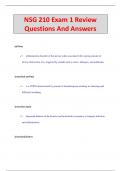
-
NSG 210 Exam 1 Review Questions And Answers
- Exam (elaborations) • 106 pages • 2024
-
- $12.49
- + learn more
Excretion is different for children. 2 considerations are... ~ ...infants under 9 months have decreased renal flow, meds are excreted more slowly, resulting in toxicity potential. What is the cause of decreased renal function in infants under 9 months? ~ lower renal blood flow, decreased glomerular filtration rate, lower renal tubular function. Two basic measurement systems for calculating pediatric doses: ~ :1. weight in kg. 2. body surface area What is the most important facet ...
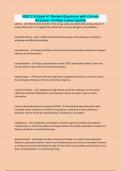
-
NSG 210 Exam #1 Review-Questions with Correct Answers/ Verified/ Latest Update
- Exam (elaborations) • 49 pages • 2024
-
- $12.49
- + learn more
asthma - inflammation disorder of the airway walls associated with varying amount of airway obstruction. It is triggered by stimuli such as stress, allergens, and pollutants. bronchial asthma - is a COPD characterized by periods of bronchospasm resulting in wheezing and difficulty breathing. bronchiectasis - abnormal dilation of the bronchi and bronchioles secondary to frequent infection and inflammation. bronchodilators - drugs used primarily to treat COPD, particularly Asthma. Some may ...
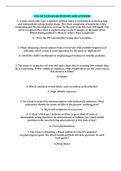
-
NSG 321 V2 EXAM QUESTIONS AND ANSWERS
- Exam (elaborations) • 23 pages • 2023
-
- $17.89
- + learn more
NSG 321 V2 EXAM QUESTIONS AND ANSWERS 1. A male client with Type 1 diabetes mellitus takes a combination of short-acting and intermediate-acting insulin drugs. The client complains of headaches when awakening and his blood glucose average for the past week has been 210 mg/dl. The nurse recognizes the client is experiencing a daily Somogyi, or rebound, effect. Which dosing method is likely to relieve these symptoms? A. Move the PM intermediate-acting dose to bedtime. 2. When obtaining ...
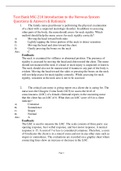
-
Test Bank NSG 210 Introduction to the Nervous System Questions & Answers & Rationale,100% CORRECT
- Exam (elaborations) • 23 pages • 2022
-
- $16.99
- + learn more
Test Bank NSG 210 Introduction to the Nervous System Questions & Answers & Rationale 1. The family nurse practitioner is performing the physical examination of a client with a suspected neurologic disorder. In addition to assessing other parts of the body, the nurse should assess for neck rigidity. Which method should help the nurse assess for neck rigidity correctly? A) Moving the head toward both sides B) Lightly tapping the lower portion of the neck to detect sensation C) Moving the head ...

-
NSG 321 V2 EXAM QUESTIONS AND ANSWERS
- Exam (elaborations) • 23 pages • 2022
-
- $14.49
- + learn more
NSG 321 V2 EXAM QUESTIONS AND ANSWERS 1. A male client with Type 1 diabetes mellitus takes a combination of short-acting and intermediate-acting insulin drugs. The client complains of headaches when awakening and his blood glucose average for the past week has been 210 mg/dl. The nurse recognizes the client is experiencing a daily Somogyi, or rebound, effect. Which dosing method is likely to relieve these symptoms? A. Move the PM intermediate-acting dose to bedtime. 2. When obtaining ...
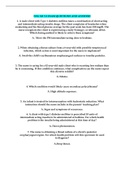
-
NSG 321 V2 EXAM QUESTIONS AND ANSWERS
- Exam (elaborations) • 23 pages • 2022
-
- $14.49
- + learn more
NSG 321 V2 EXAM QUESTIONS AND ANSWERS 1. A male client with Type 1 diabetes mellitus takes a combination of short-acting and intermediate-acting insulin drugs. The client complains of headaches when awakening and his blood glucose average for the past week has been 210 mg/dl. The nurse recognizes the client is experiencing a daily Somogyi, or rebound, effect. Which dosing method is likely to relieve these symptoms? A. Move the PM intermediate-acting dose to bedtime. 2. When obtaining ...
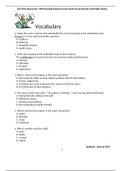
-
HESI Study Group Review all questions are answered correctly
- Exam (elaborations) • 40 pages • 2021
-
- $10.99
- 1x sold
- + learn more
HESI Study Group Review all questions are answered correctly 1. Select the word or phrase that will identify the correct meaning of the underlined word. Progeny is a term used to describe a person’s A. creditors B. offspring C. hereditary disease D. health status 2. Select the meaning of the underlined word in the sentence, The proliferation of resistant bacteria has alarmed medical professionals. A. increase B. reduction C. strength D. appearance 3...
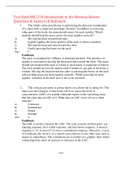
-
Test Bank NSG 210 Introduction to the Nervous System Questions & Answers & Rationale,100% CORRECT
- Exam (elaborations) • 23 pages • 2022
-
- $16.99
- + learn more
Test Bank NSG 210 Introduction to the Nervous System Questions & Answers & Rationale 1. The family nurse practitioner is performing the physical examination of a client with a suspected neurologic disorder. In addition to assessing other parts of the body, the nurse should assess for neck rigidity. Which method should help the nurse assess for neck rigidity correctly? A) Moving the head toward both sides B) Lightly tapping the lower portion of the neck to detect sensation C) Moving the head ...

Study stress? For sellers on Stuvia, these are actually golden times. KA-CHING! Earn from your study resources too and start uploading now. Discover all about earning on Stuvia


